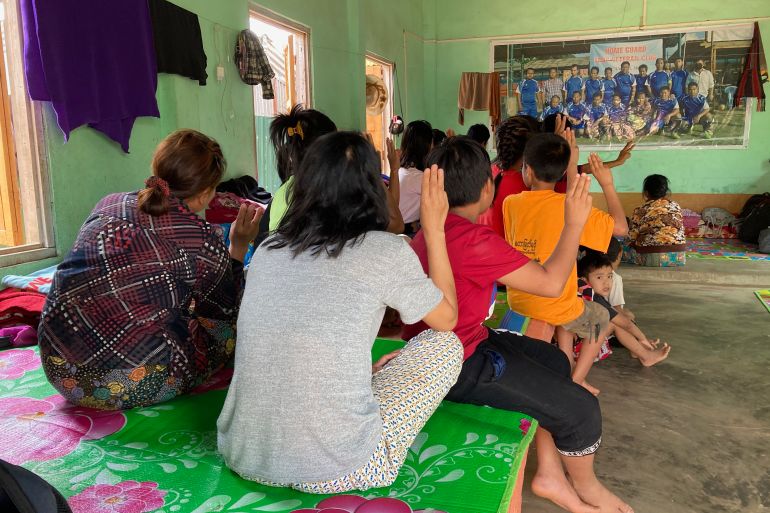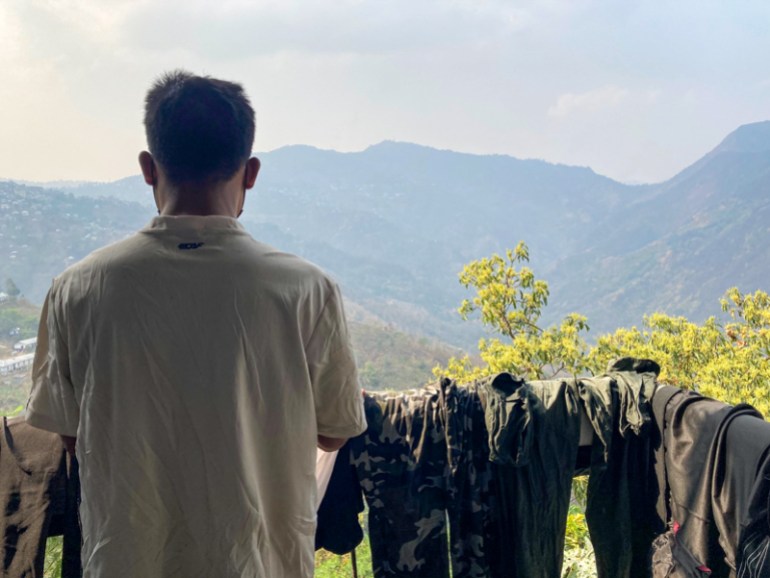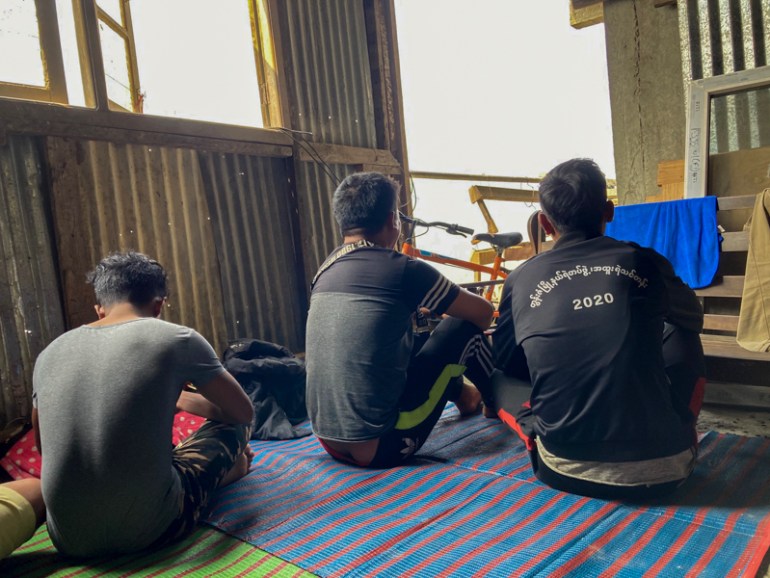Myanmar nationals given ‘safe passage’ to Delhi to seek UN refuge
Seven, including three journalists, set to travel to India’s capital to approach UNHCR after Manipur court orders safe passage for them.

Moreh, Manipur, India – Seven Myanmar nationals, including three journalists from a Yangon-based media house, are set to travel to New Delhi to approach the India office of the United Nations High Commissioner for Refugees (UNHCR) after a court in the northeastern state of Manipur ordered safe passage for them on Monday.
The seven Myanmar nationals had been “hiding” in Moreh, a border town in Manipur’s Tengnoupal district, for weeks before they arrived in the state capital Imphal on April 21 following court-ordered interim protection.
Keep reading
list of 4 itemsAt least 8 reported killed in Myanmar anti-coup protests
Myanmar’s UN ambassador: ‘Military coup must fail’
Almost half of Myanmar risks falling into poverty by 2022: UNDP
The seven are among hundreds of Myanmar nationals, including policemen, military personnel and legislators, who are seeking shelter in the Indian states of Manipur and Mizoram after they fled to escape a brutal crackdown following a military coup on February 1 this year.
Many of those who fled are members of the anti-coup Civil Disobedience Movement (CDM), which has been protesting to demand the reinstatement of the civilian government in Myanmar.
More than 750 protesters have been killed in the crackdown, according to reports, even as ethnic armed groups continue to confront the military government.
In their order on Monday, the judges at the Manipur High Court made a distinction between migrants and refugees seeking asylum.
“They did not enter our country with the clear-cut and deliberate intention of breaking and violating our domestic laws. They fled the country of their origin under imminent threat to their lives and liberty,” the judges said.
Citing media coverage from Myanmar, the judges said there is “no doubt that these Myanmarese persons, given their links with the banned Mizzima Media Organization, face an imminent threat to their lives and liberty if they return”.
“This court finds it just and proper to extend protection under Article 21 of the Constitution to these seven Myanmarese persons and grant them safe passage to New Delhi to enable them to avail suitable protection from the UNHCR,” they said, asking the governments in New Delhi and Manipur to facilitate their travel.
Senior human rights lawyer Nandita Haksar had filed the petition on behalf of the seven Myanmar nationals, claiming they could be deported back to Myanmar by the Assam Rifles, the paramilitary force that guards the India-Myanmar border.
The seven include Sit Thau Aung, a 43-year-old video journalist, Chin San Lun, a web designer, Pau Khan Thawn, a webmaster, his wife and three children.
Haksar cited a March 10 letter issued by India’s home ministry to the states bordering Myanmar and the Assam Rifles, directing them to check the influx of “illegal immigrants” from Myanmar.
The letter said India is not a signatory to the United Nations Refugee Convention of 1951 or its 1967 protocol and hence not obliged to give the Myanmar nationals shelter.
Haksar on Monday told Al Jazeera they would soon catch a flight to New Delhi.
“They wanted to go to Delhi and hopefully now they will get the UNHCR certificate,” she said, adding that the agency insists on the presence of the applicants in the city to process their asylum claims.

Thawn and his wife took refuge in India in 2007 during the Saffron Revolution in Myanmar, Haksar’s petition and the court order notes. They went back after the situation normalised in Myanmar.
The Saffron Revolution was a series of mass protests in 2007, sparked by a hike in fuel prices but which soon took the shape of a movement against the military rulers. Buddhist monks were at the forefront of the protests, hence the name saffron in reference to their robes.
In March this year, as the situation in Myanmar deteriorated and the military started cracking down on dissident journalists, Thawn, along with his family and colleagues, packed their bags to escape.
After two days of bus journeys and a short trek through the hills, the seven crossed the border and arrived in Moreh on March 22.
“There was a media shutdown. The military had started arresting media people,” Aung told Al Jazeera, detailing the circumstances of his escape. He claimed to be on the military’s list of wanted journalists and said there was a warrant pending against him.
Aung and his colleagues had covered the aftermath of the coup in February. “We were livestreaming it,” said Aung.
On March 8, the military revoked Mizzima’s publishing and broadcasting licence.
“They raided our head office of broadcasting in Yangon on March 9 and took away whatever they found,” Soe Myint, founder of Mizzima, said in an email to Al Jazeera from an undisclosed location.
Myint said he was also active in the 1988 pro-democracy uprising against the military government, which was brutally crushed by them. In 1990, he was one of the two involved in hijacking a Thai Airways plane that was diverted to the Indian city of Kolkata.
The duo had demanded that police allow them to address a news conference to tell the world what was happening in Burma (Myanmar’s former name).
Myint later founded the Mizzima news organisation in 1998 in New Delhi where he lived as a refugee.
Myint said three Mizzima journalists were arrested in February and March, while three other former staffers, including co-founder and Myint’s wife Thin Thin Aung, were picked up on April 8.

Meanwhile, Moreh, the small border town, continues to play host to more than 1,000 Myanmar nationals, mostly from the Sagaing Division which saw fierce clashes between the protesters and the military.
Tamu, the township across from Moreh, has fallen quiet over the last few days, according to Jangman Haokip, president of the Hill Tribal Council, a community organisation representing a section of the local tribal communities who live in this part of Manipur.
“But people are still apprehensive. They don’t want to go back,” he said. “Centre and state should do something for the sake of these people.”
Locals complain that the state government has not offered any support and has left it to the community organisations to take care of the Myanmar nationals.
In neighbouring Mizoram, the number of Myanmar nationals seeking shelter has grown to more than 3,000, according to local community organisations.
The Manipur High Court order has raised the hopes of many of these Myanmar nationals that they can seek refuge in India.
Bernard L Chhangte, president of United for Democratic Myanmar NGO, an umbrella group of more than 20 local civil society groups involved in helping the Myanmar nationals in Mizoram, said they are studying the court’s order and considering further action.
“It may also be noted that though India has no clear refugee protection policy or framework, it does grant asylum to a large number of refugees from nearby countries. India usually respects the UNHCR’s recognition of the status of such asylum seekers, mainly from Afghanistan and Myanmar,” the Manipur High Court order notes.
Haksar hoped India would give asylum to “genuine refugees”.
“The significance of this order is that the high court made a distinction between refugee and migrant. That is a very important distinction. Anyone who is a refugee should be able to take advantage of the order,” she said.